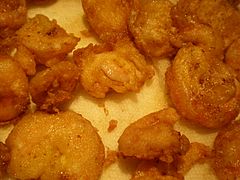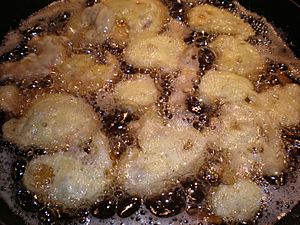Camaron rebosado facts for kids
 |
|
| Alternative names | rebosadong hipon |
|---|---|
| Course | Main dish |
| Place of origin | Philippines |
| Serving temperature | Hot |
| Main ingredients | shrimp, batter |
| Variations | Camaron rebosado con jamon |
Camaron rebosado is a yummy Filipino dish. It features shrimp that are covered in a special batter and then deep-fried until crispy. People usually enjoy it with a tasty sweet and sour sauce. It's a very popular meal in the Philippines.
Contents
What's in the Name?
The name Camaron rebosado comes from the Spanish words. Camaron means "shrimp". Rebosado means "battered" in the Tagalog language. Even though the name is Spanish, this dish actually came from Chinese Filipino people. Chinese travelers first brought it to the Philippines.
How to Make Camaron Rebosado
Making Camaron rebosado starts with fresh shrimp. First, the heads are removed. Sometimes, the tails are taken off too. Then, the shrimp is cut lengthwise along its back. This makes it "butterflied" and easy to clean.
Next, the shrimp gets a quick marinade. It soaks in a mix of calamansi juice, salt, black pepper, and garlic. Other spices can be added for extra flavor. This step helps the shrimp taste even better.
The special batter is made by mixing flour with egg, black pepper, and water. Sometimes, corn starch or baking powder is added. This makes the batter light and crispy. Each shrimp is coated evenly in this batter. After that, they are fried in hot oil until golden brown. Some people also like to roll the shrimp in bread crumbs before frying them.
Serving Up This Dish
Camaron rebosado is traditionally served with a delicious sweet and sour sauce. This sauce is also known as agre dulce. You can pour the sauce right over the cooked shrimp. Or, you can serve it on the side as a dipping sauce.
There are other yummy ways to enjoy this dish. Some people like it with soy sauce and calamansi juice. This mix is called toyomansi. You can also try it with garlic-flavored mayonnaise. Or, you might like it with tomato and banana ketchup.
This dish is a bit like Japanese tempura. However, tempura uses a lighter batter. That batter is also chilled before frying.
Different Kinds of Camaron Rebosado
A special version of this dish is called Camaron rebosado con jamon. This means "battered shrimp with ham". In this recipe, a piece of ham is wrapped around the shrimp. Then, it's covered in batter and fried. This tasty variation is a traditional dish. You can find it in the Binondo district of Manila. Binondo is Manila's famous Chinatown.
See also
 In Spanish: Camarón rebozado para niños
In Spanish: Camarón rebozado para niños


